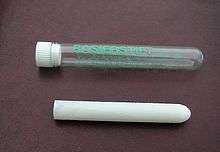Antihemorrhagic
An antihemorrhagic (antihæmorrhagic) agent is a substance that promotes hemostasis (stops bleeding).[1] It may also be known as a hemostatic (also spelled hæmostatic) agent.[2]
A styptic (also spelled stiptic) is a specific type of antihemorrhagic agent that works by contracting tissue to seal injured blood vessels. Styptics are also referred to as local hemostatics. Styptic pencils contain astringents.[3]
Antihemorrhagic agents used in medicine have various mechanisms of action:
- Systemic drugs work by inhibiting fibrinolysis or promoting coagulation.
- locally acting hemostatic agents work by causing vasoconstriction or promoting platelet aggregation.
Medical uses
Hemostatic agents are used during surgical procedures to achieve hemostasis and are categorized as hemostats, sealants and adhesives. They vary based on their mechanism of action, composition, ease of application, adherence to tissue, immunogenicity and cost. These agents permit rapid hemostasis, better visualization of the surgical area, shorter operative times, decreased requirement for transfusions, decreased wound healing time and overall improvement in patient recovery time.[4]
Types
Systemic
There are several classes of antihemorrhagic drugs used in medicine. These include antifibrinolytics, blood coagulation factors, fibrinogen, and vitamin K.[5]
Local
Topical hemostatic agents have been gaining popularity for use in emergency bleeding control, especially in military medicine. They are available in two forms—as a granular powder poured on wounds, or embedded in a dressing.[6]
Organic
Microfibrillar collagen
Microfibrillar collagen hemostat (MCH) is a topical agent composed of resorbable microfibrillar collagen. It attracts platelets and allows for the formation of a blood clot when it comes into contact with blood. Unlike the hemostatic clamp, no mechanical action is involved. The surgeon presses the MCH against a bleeding site, and the collagen attracts and helps with the clotting process to eventually stop bleeding.[7]
The practical application for MCH is different from that of the hemostatic clamp.[8]
Chitosan
Chitosan hemostats are topical agents composed of chitosan and its salts. Chitosan bonds with platelets and red blood cells to form a gel-like clot which seals a bleeding vessel. Unlike other hemostat technologies its action does not require the normal hemostatic pathway and therefore continues to function even when anticoagulants like heparin are present.[9]
Chitosan is used in some emergency hemostats which are designed to stop traumatic life-threatening bleeding. Their use is well established in many military and trauma units.[10]
Inorganic
Kaolin and zeolite activate the coagulation cascade, and have been used as the active component of hemostatic dressings (for example, in QuikClot).[11]
Styptics

Styptics cause hemostasis by contracting blood vessels.
A common delivery system for this is a styptic or hemostatic pencil (not to be confused with a caustic pencil). This is a short stick of medication. Anhydrous aluminium sulfate is the main ingredient and acts as a vasoconstrictor in order to disable blood flow. The stick is applied directly to the bleeding site. The high ionic strength promotes flocculation of the blood, and the astringent chemical causes local vasoconstriction. Before safety razors were invented, it was a standard part of a shaving kit and was used to seal shaving cuts.[12] Some people continue to use styptic pencils for minor skin wounds from safety or electric razors.[12]
Styptic powder is used in the veterinary trade to stop bleeding from nails that are clipped too closely. This powder is generally used on animals, such as cats, dogs, and rabbits, whose vein is found in the center of the nail.[13]
See also
- ATC code B02 – Antihemorrhagics
- Hemostatic clamp
References
- "antihemorrhagic" at Dorland's Medical Dictionary
- "hemostat" at Dorland's Medical Dictionary
- "astringent" at Dorland's Medical Dictionary
- Vyas, Krishna S; Saha, Sibu P (22 October 2013). "Comparison of hemostatic agents used in vascular surgery". Expert Opinion on Biological Therapy. 13 (12): 1663–1672. doi:10.1517/14712598.2013.848193. PMC 4390172. PMID 24144261.
- Pharmacology ReCap 2.0 for Bachelor of Dentistry Students. Quick Review of Pharmacology.
- "When to use hemostatic agents in EMS". EMS1. Retrieved 2016-03-14.
- Sundaram, Chandru P.; Keenan, Alison C. (2010-01-01). "Evolution of hemostatic agents in surgical practice". Indian Journal of Urology. 26 (3): 374–378. doi:10.4103/0970-1591.70574. ISSN 0970-1591. PMC 2978438. PMID 21116358.
- Dong, Shaosheng (Nov 6, 2014), Film forming personal care compositions and methods, retrieved 2016-03-14
- Millner, Russell; Lockhart, Alan S; Marr, Rebecca (2010-10-01). "Chitosan arrests bleeding in major hepatic injuries with clotting dysfunction: an in vivo experimental study in a model of hepatic injury in the presence of moderate systemic heparinisation". Annals of the Royal College of Surgeons of England. 92 (7): 559–561. doi:10.1308/003588410X12699663903593. ISSN 0035-8843. PMC 3229344. PMID 20522310.
- "Military Experts Say Newer Hemostatic Dressings Beat Gauze // ACEP". www.acep.org. Archived from the original on 2016-03-15. Retrieved 2016-03-14.
- "HOW QUIKCLOT BRAND PRODUCTS WORK TO STOP BLEEDING" (PDF). Z-Medica Corporation. Archived from the original (PDF) on 23 September 2014.
- "Styptic Pencil what is it, how to use at Executive Shaving". Executive-shaving.co.uk. 2015-08-21. Archived from the original on 2013-09-01. Retrieved 2015-10-20.
- "Pet first-aid kit contents". www.vet.cornell.edu. Archived from the original on 2009-07-29. Retrieved 2016-03-14.
| Look up styptic in Wiktionary, the free dictionary. |